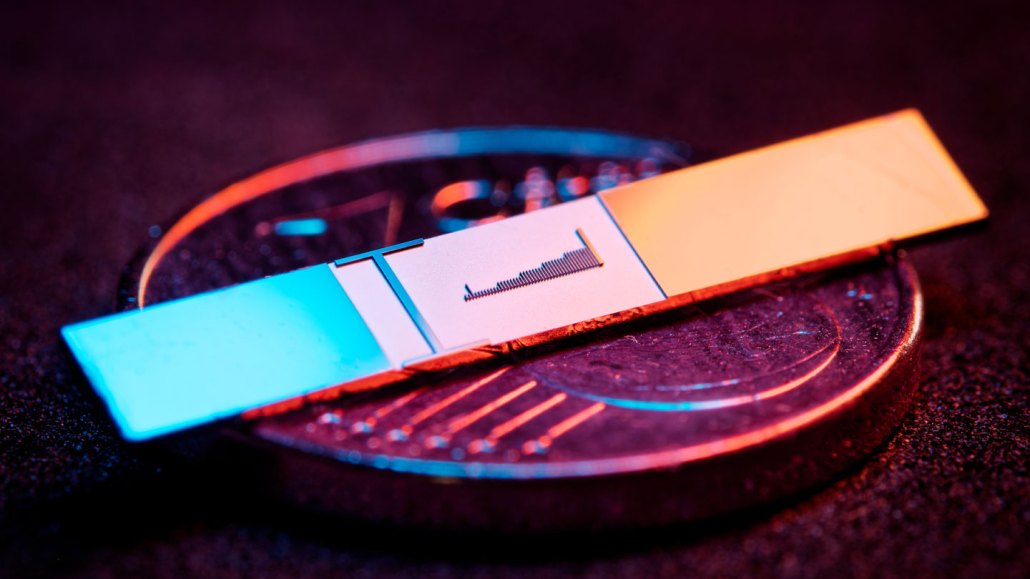
A miniature accelerator chip fits on a 1 euro cent coin. The pictured chip contains 42 different particle accelerators of various lengths. When hit with laser light, an accelerator gives an energy boost to electrons passing through.
S. Kraus and J. Litzel/Laserphysics/FAU
- More than 2 years ago
One day, powerful particle accelerators might fit in your pocket.
Two teams of physicists have built tiny structures that both accelerate electrons and keep them confined in a manageable beam, instead of spewing them willy-nilly. That’s a first for such mini accelerators, and a crucial step toward making these devices more useful and widespread.
“One of the main problems with particle accelerators … is that they’re too big and they’re too expensive,” says physicist Jared Maxson of Cornell University, who was not involved with the new research. Miniaturizing the devices means scientists could make high-energy electrons on a tabletop, Maxson says. That could open up new possibilities for medicine and science.
Constructed on silicon chips, the accelerators are composed of two rows of pillars about 2 micrometers tall, reminiscent of miniature rows of skyscrapers. When hit with laser light, the pillar structure generates electromagnetic fields that push the subatomic particles faster and faster along an extremely narrow alley between the pillars, less than a micrometer wide.
Electrons in one device gained 12.3 kiloelectron volts of energy over a distance of half a millimeter, a 43 percent bump that brought the particles to 40.7 kiloelectron volts, physicist Peter Hommelhoff and colleagues report October 18 in Nature.
Meanwhile, carefully placed gaps between the pillars help keep the beam of electrons in focus, mimicking the capabilities of larger accelerators. “This is really the first accelerator based on nanophotonics that contains all the features any modern accelerator contains,“ says Hommelhoff, of the University of Erlangen-Nuremberg in Germany.
Physicist Robert Byer of Stanford University and colleagues reported a similar achievement October 3 at arXiv.org, with energy gains up to 23.7 kiloelectron volts. The two groups are part of a larger collaboration called the Accelerator on a Chip International Program, or ACHIP, which unifies efforts to build these small accelerators.
The world’s most powerful particle accelerator is the Large Hadron Collider, or LHC, near Geneva, with a ring that’s a whopping 27 kilometers around. Protons in the LHC reach energies of trillions of electron volts. The new tiny accelerators, with mere thousands of electron volts, won’t be creating Higgs bosons anytime soon — the particle famously found at the LHC in 2012 (SN: 6/29/22). But such devices have their own set of potential applications.
For example, high-energy electrons can treat skin cancer by damaging the DNA within cancer cells, killing them. But generating the energetic electrons currently requires a roomful of bulky machinery. With an accelerator on a chip, electron beam therapy could become more accessible.
And similar treatments could go more than skin-deep. “The dream is to be able to have a fiber that can go in a human body to do a local radiation treatment … because the whole accelerator can fit inside you,” says Pietro Musumeci of UCLA, who is a member of ACHIP but was not involved with the new results.
Another application could involve using the devices to create special states of light that could be useful for quantum computing. Or the accelerators might be useful for materials research, for example, for making images of thin materials with ultrahigh time resolution.
But the accelerators still have a long way to go. Electrons emerge from the devices at a rate that’s many orders of magnitude below conventional accelerators. And while the devices focus the beam in two dimensions (in the direction of the beam and perpendicular to it horizontally), further work is needed to focus the beam vertically.
The devices’ energy gains still need to be scaled up, too. The energy the electrons accumulate over a given acceleration distance is on par with conventional accelerators, tens of millions of electron volts per meter. But scientists want to far surpass those accelerators with billions of electron volts per meter.
Even so, the work demonstrates techniques that once seemed absurd to attempt. At first, when Byer described the idea to colleagues, “they’d all break out in hilarious laughter,” he says. “We don’t get laughter anymore; we now get appreciation.”







